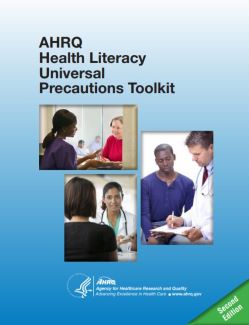Clear Health Communication Tools and Resources

On this page you will find a number of select videos, tutorials and guides that explain why and how to incorporate health literacy principles in your practice, as well as quick-start guides to help you get started.The following resources cover how to:
- Ensure your patients feel welcome and help them navigate your practice
- Improve communication with your patients in clinical encounters
- Create and assess patient print and online education materials
Tutorials: Using Lay Language in Health Communication
The following modules explore the importance of using lay language in health communication. They explain how to assess and improve readability of materials using clear communications techniques, as well as outline sources of health information for patients. All modules were produced by the Health Sciences Library at the University of North Carolina at Chapel Hill.
- Definitions of health literacy and plain language
- Health literacy levels in the United States
- Examine the relationship between health literacy and patient outcomes
- Learn to recognize and meet the needs of patients with low health literacy skills using either validated tools or adopting the Health Literacy Universal Precautions approach
Links to resources covered in Module 1:
- Healthy People 2030: Health Literacy Definition
- PlainLanguage.gov
- National Assessment of Adult Literacy (NAAL)
- The Health Literacy of America’s Adults: Results from the 2003 National Assessment of Adult Literacy.
- Health Literacy Tool Shed (More than 100 tools to assess an individual’s health literacy)
- Health Literacy Universal Precautions Toolkit
- American Medical Association Health Literacy video (short version)
- What is readability?
- How readability formulas work
- Factors that affect readability
- Recommended reading grade levels
- Ways to calculate reading grade level of materials
Links to resources covered in Module 2:
- National Institutes of Health (NIH) Information on Clear Communication
- Making Health Communication Programs Work
- How to Test Readability of Your Writing in Microsoft Word or Outlook
- Get Your Document’s Readability and Level Statistics
- WordCalc
- Textcompare.org
- ReadabilityFormulas.com
- Hemingway App
- A selection of plain language tools
- Review of best practices for formatting and writing patient education materials
- Using or modifying existing materials
- Two tools to help you develop and revise materials
Links to resources covered in Module 3:
- PlainLanguage.gov
- Plain Language Medical Dictionary
- Everyday Words for Public Health Communication
- Thesaurus.com
- Dictionary.com
- Patient Education Materials Assessment Tool (PEMAT)
- CDC Clear Communication Index
- Use Zombies to Fight Passive Voice
- Effective patient-provider interactions
- Substituting words for better comprehension
- Using or modifying existing materials
- Best practices including the Teach-Back Method
Links to resources covered in Module 4:
- The Noun Project - use to find icons and photos for word substitutions
- Article “Patients’ memory for medical information” - Journal of the Royal Society of Medicine
- Always Use Teach-back Training Toolkit
- 10 Elements of Competence for Using Teach-back Effectively
- Consumer Health site from the National Library of Medicine, one of the National Institutes of Health
- Consumer Health site from the Health Sciences Library (HSL), University of North Carolina, Chapel Hill
- “Ask a Librarian” service from the HSL
Links to resources covered in Module 5:
- MedlinePlus.gov
- MedlinePlus Health Topics, Easy-to-Read Section
- NC Health Info
- NC Health Info “Ask a Librarian” service
15 best practices for patient-centered communication
This video demonstrates 15 best practices for patient centered communication, organized under habits.
Watch 15 best practices for patient-centered communication (18.18 min.)
The Teach-back Method
The teach-back method is a way to ensure patients understands what is being explained to them by their healthcare provider. If they understand, they are able to correctly “teach-back” the information. The following videos demonstrate various aspects of the teach-back method.
- What Is Teach-Back? (Institute for Healthcare Improvement) – 1.22 min.
- Teach back method (general) (Sheps Center for Health Services Research) – 4.46 min.
- Teach-back Strategy (Agency for Healthcare Research and Quality) – 32.16 min.
- Person-centred tools and approaches: Teach-back (Healthcare Improvement Scotland) – 12.04 min.
- Teach-Back Toolkit: The purpose of this toolkit is to help all health care providers learn to use teach-back—every time it is indicated—to support patients and families throughout the care continuum, especially during transitions between health care settings.
- Cardiology Practice Teach Back (Sheps Center for Health Services Research) – 4.34 min.
- Heart Failure Medication Instructions Teach back Method (Truman Medical Centers/University Health) – 3.24 min.
- Hospital Discharge Teach-back (UCLA Department of Nursing) – 1.55 min.
- Rheumatology practice Teach back in a (Sheps Center for Health Services Research) – 3.35 min.
Implementing Health Literacy in Your Practice

Health Literacy Universal Precautions Toolkit
The AHRQ Health Literacy Universal Precautions Toolkit provides evidence-based guidance for pediatrics and general practitioners on eliminating unnecessary complexities in health care delivery. Doing so improves patient understanding of health information. The toolkit contains 21 tools, as well as a Quick Start Guide to help you assess health literacy in your practice.
Toolkit for Engaging Patients To Improve Diagnostic Safety (AHRQ)
The toolkit contains two strategies, Be The Expert On You and 60 Seconds To Improve Diagnostic Safety. When paired together, these strategies enhance communication and information sharing within the patient-provider encounter to improve diagnostic safety. Each strategy contains practical materials to support adoption of the strategy within office-based practices.
National Action Plan to Improve Health Literacy
This National Action Plan to Improve Health Literacy seeks to engage organizations, professionals, policymakers, communities, individuals, and families in a linked, multi-pronged effort to improve health literacy. The plan is based on the principles that (1) everyone has the right to health information that helps them make informed decisions and (2) health services should be delivered in ways that are understandable and beneficial to health, longevity, and quality of life.
Communicating with Patients
How to Create Actionable and Engaging Patient Education (Lifeology)
This course will help you learn to create patient education that engaging, helps people make sense of health information, and it’s easy to understand and act on.
Health Literacy Online: A Guide for Simplifying the User Experience (ODPHP)
Helps you develop intuitive health websites and digital tools that can be easily accessed and understood by all users.
Choosing Effective Patient Education Materials – MedlinePlus
Guidelines for selecting patient education materials.
Develop & Test Health Literacy Materials from the Centers for Disease Control (CDC)
These resources assist with understanding your audience, visual communication, and testing messages and materials when developing a wide array of health information.
Ask Me 3
This program is designed to improve communication between patients and health care providers, encourage patients to become active members of their health care team, and promote improved health outcomes. The program encourages patients to ask their health care providers three questions:
- What is my main problem?
- What do I need to do?
- Why is it important for me to do this?
Training and Additional Learning
Health Literacy for Health Professionals (CDC)
The purpose of this public health literacy web-based training program is to educate public health professionals about public health literacy and their role in providing health information and services and promoting public health literacy.
Find Training for Health Professionals (CDC)
The Centers for Disease Control (CDC) offers 6 online health literacy courses for health professionals.






